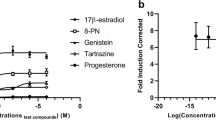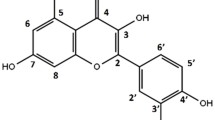Summary
Following the well established prevention of chemical carcinogenesis by vitamin A in several species of laboratory animals, we performed in vitro studies with human diploid fibroblasts in culture. Vitamin A-palmitate, alltransretinoic acid and the analogue compound Ro 10-9359 were found to reduce the formation of active intermediates following the administration of G3H Benzo(a)pyrene to the cells. This effect which lead to a considerable decrease of alkylated DNA is not based on a direct inhibition of Benzpyrene metabolizing enzymes by the retinoids but by a preferential inhibition of the de novo synthesis of these enzymes. This caused the well known substrate mediated enzyme induction of benzpyrene metabolizing enzymes to cease. From our data we conclude that the mechanism of the cancer protective effect of vitamin A with respect to certain carcinogens is based on an inhibited activation of procarcinogens. This effect can also be expected in human tissues.
Zusammenfassung
Ausgehend von bekannten tierexperimentellen Daten über eine protektive Wirkung von Vitamin A und seinen Analogen gegenüber der Tumor-Auslösung durch chemische Cancerogene wurden in vitro-Untersuchungen an Fibroblastenkulturen vom Menschen durchgeführt. Wir untersuchten den Einfluß von Vitamin A-Palmitat und seinen chemischen Analogen Ro 10-9359 und All-Trans-Retinsäure auf den Abbau von G-3H-Benzo(a)pyren zu wasserlöslichen Produkten und die Adduktion radioativer Intermediate an die DNS. Retinoide reduzierten konzentrationsabhängig den enzymatischen Abbau von Benzpyren und die Benzpyren-abhängige Alkylierung von DNS, dabei hemmten Retinoide den enzymatischen Abbau von Benzpyren nicht direkt, sondern die substratabhängige Induktion der abbauenden Enzyme über eine Reduktion der Proteinsynthese, die als 3H-Leucin-Einbau in Fibroblasten gemessen wurde. Anders als durch Cycloheximid und Actinomycin D kam es durch Retinoide nicht zur generellen Blockade der Eiweißsynthese, sondern zur bevorzugten Hemmung der induzierbaren Enzyme des Benzpyrenabbaus.
Wir schließen aus diesen Untersuchungen, daß der Mechanismus der protektiven Wirkung von Retinoiden gegenüber bestimmten chemischen Cancerogenen über eine Hemmung der Aktivierung von Pro-Cancerogenen führt, und daß diese protektive Wirkung auch an Zellen vom Menschen nachweisbar ist.
Similar content being viewed by others
Abbreviations
- BP :
-
Benzo(a)pyren
- FCS :
-
Fetales Kälberserum
- DNS :
-
Desoxyribonucleinsäure
- RNS :
-
Ribonucleinsäure
- ANF :
-
Alpha-Naphthoflavon
- CH :
-
Cycloheximid
Literatur
Bollag, W.: Effects of vitamin A acid (NCS-122758) on transplantable and chemically induced tumors. Cancer Chemother. Rep. 55, 53–58 (1971)
Bollag, W.: Therapeutic effects of an aromatic retinoic acid analog on chemically induced skin papillomas and carcinomas of mice. Europ. J. Cancer. 10, 731–737 (1974)
Bollag, W.: Prophylaxis of chemically induced epithelial tumors with an aromatic retinoic acid analog (Ro 10-9359). Europ. J. Cancer 11, 721–724 (1975)
Bresnick, E., McDonald, Th.F., Yagi, H., Jerina, D.M., Levin, W., Wood, A. W., Conney, A. H.: Epidermal hyperplasia after topical application of benzo(a)pyrene, benzo(a)pyrene diol epoxides, and other metabolites. Cancer Res. 37, 984–990 (1977)
Brookes, P.: Quantitative aspects of the reaction of some carcinogens with nucleic acids and the possible significance of such reactions in the process of carcinogenesis. Cancer Res. 26, 1994 (1966)
Burton, K.: A study of the conditions and mechanism of the diphenylamine reaction for the colorimetric estimation of deoxyribonucleic acid. Biochem. J. 62, 315–323 (1956)
Cone, M. V., Nettesheim, P.: Effect of vitamin A on 3-methyl-cholanthrene-induced squamous metaplasias and early tumors in the respiratory tract of rats. J. Nat. Cancer Inst. 50, 1599–1906 (1973)
Diamond, L., Gelboin, H. V.: Alpha-naphthoflavone: An inhibitor of hydrocyrbon cytotoxicity and microsomal hydroxylase. Science 166, 1023–1025 (1969)
Gross-Bellard, M., Oudet, P., Chambon, P.: Isolation of high-molecular-weight DNA from mammalian cells. Europ. J. Biochem. 36, 32–38 (1973)
Hubermann, E., Sachs, L.: Metabolism of the carcinogenic hydrocarbon benzo(a)pyrene in human fibroblasts and and epithelial cells. Int. J. Cancer 11, 412–418 (1973)
Jung, A., Bauer, E., Lenger, K., Scholz, A., Jackisch, R.: Untersuchungen zum cytostatischen Wirkungsmechanismus der Vitamin A-Säure. Z. Krebsforsch. 82, 223–231 (1974)
Kellermann, G., Luyten-Kellermann, M., Shaw, C. R.: Genetic variation of aryl hydrocarbon hydroxylase in human lymphocytes. Amer. J. Hum. Genet. 25, 327–331 (1973)
Lasnitzki, I., Goodman, S.: Inhibition of the effects of methylcholanthrene on mouse prostate in organ culture by vitamin A and its analogs. Cancer Res. 34, 1564–1571 (1974)
Levij, I. S., Polliack, A.: Potentiating effect of vitamin A on 9,10-dimethyl-1,2-benzanthracenecarcinogenesis in the hamster cheek pouch. Cancer 22, 300–306 (1968)
Levij, I. S., Rwomushana, J. W., Polliack, A.: Enhancement of chemical carcinogenesis in the hamster cheek pouch by prior topical application of vitamin A palmitate. J. Invest. Dermatol. 53, 228–231 (1969)
Maugh II, Th. H.: Vitamin A.: Potential protection from carcinogens. Science 186, 1198 (1974)
Miller, J. A.: Carcinogenesis by chemicals: An overview-G.H.A. Clowes Memorial Lecture. Cancer Res. 30, 559–576 (1970)
Moon, R. C., Grubbs, C. J., Sporn, M. B., Goodman, D. G.: Retinyl acetate inhibits mammary carcinogenesis induced by N-methyl-N-nitrosourea. Nature 267, 620–621 (1977)
Nebert, D. W., Gielen, J. E.: Genetic regulation of aryl hydrocarbon hydroxylase in the mouse. Fed. Proc. 31, 1315–1325 (1972)
Nebert, D. W., Robinson, J. R., Niwa, A., Kumaki, K., Poland, A. P.: Genetic expression of aryl hydrocarbon hydroxylase activity in the mouse. J. Cell. Physiol. 85, 393–414 (1975)
Oesch, F., Glatt, H. R.: Mutagenicity of benzo(a)pyrene: metabolic activation, inactivation and reactivation. Experientia 31, 720 (1975)
Paul, J.: Cell and tissue culture. 5th Edition, Edinburgh: Churchill Livingstone 1975
Saffiotti, U., Montesano, R., Sellakumar, A. R., Borg, S. A.: Experimental cancer of the lung. Inhibition by vitamin A of the induction of tracheobronchial squamous metaplasia and squamous cell tumors. Cancer 20, 857–864 (1967)
Schmähl, D., Krüger, C., Preissler, P.: Versuche zur krebsprophylaxe mit Vitamin A. Arzneim. Forsch. 22, 946–949 (1972)
Schmähl, D., Habs, M.: Experiments on the influence of an aromatic retinoid on the chemical carcinogenesis in rats by butyl-butanol-nitrosamine and 1,2-dimethylhydrazine. Arzneim. Forsch. 28, 49–51 (1978)
Sims, P.: Epoxides as relative intermediates in aromatic hydrocarbon metabolism. Biochem. Soc. Transact. 3, 59 (1975)
Sims, P., Grover, P. L.: Expoxides in polycyclic aromatic hydrocarbon metabolism and carcinogenesis. Advances in Cancer Res. 20, 165–274 (1974)
Smith, D. M., Rogers, A. E., Herndon, B. J., Newberne, P. M.: Vitamin A (retinyl acetate) and benzo(a)pyrene-induced respiratory tract carcinogenesis in hamsters fed a commercial diet. Cancer Res. 35, 11–16 (1975)
Smith, D. M., Rogers, A. E., Newberne, P. M.: Vitamin A and benzo(a)pyrene carcinogenesis in the respiratory tract of hamsters fed a semisynthetic diet. Cancer Res. 35, 1485–1488 (1975)
Sporn, M. B.: 13-cis-retinoic acid: Inhibition of bladder carcinogenesis in the rat. Science 195, 487–489 (1977)
Sporn, M. B., Dunlop, N. M., Newton, D. L., Smith, J. M.: Prevention of chemical carcinogenesis by vitamin A and its synthetic analogs (retinoids). Fed. Proc. 35, 1332–1338 (1976)
Thorgeirsson, S. S., Nebert, D. W.: The Ah locus and the metabolism of chemical carcinogenesis and orther foreign compounds. Cancer Res. 34, 149–193 (1977)
Tomingas, R., Pott, F., Dehnen, W.: Polycyclic aromatic hydrocarbons in human bronchial carcinoma. Cancer Letters 1, 189 (1976)
Author information
Authors and Affiliations
Rights and permissions
About this article
Cite this article
Kohl, F.V., Rüdiger, H.W. In vitro-Untersuchungen an menschlichen Zellkulturen zur Tumorprophylaxe durch Vitamin A. J Cancer Res Clin Oncol 93, 149–160 (1979). https://doi.org/10.1007/BF00406572
Received:
Accepted:
Issue Date:
DOI: https://doi.org/10.1007/BF00406572




